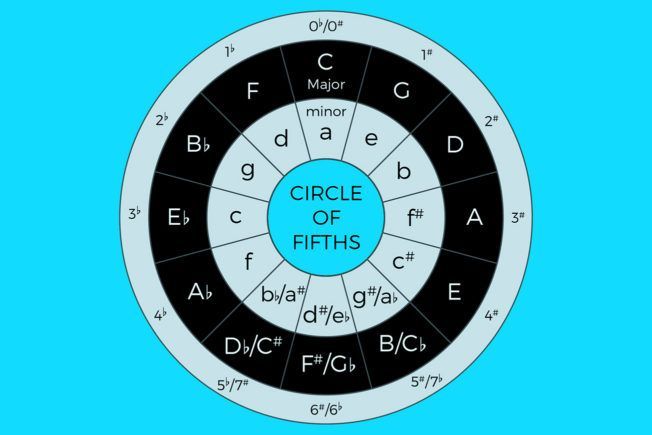What is the Circle of Fifths? Learn how to use the Circle of Fifths to understand basic music theory and to improve your songwriting skills.

What is the Circle of Fifths?
The Circle of Fifths is a visual diagram that shows the relationship among the twelve notes of the chromatic scale, associated major and minor keys, and their corresponding key signatures.
Each note displayed around the Circle of Fifths is a perfect fifth apart from another. A perfect fifth interval is the distance of seven semitones. For example, C to G on the circle represents a perfect fifth.
Memorizing the Circle of Fifths can help you understand music theory. It shows how all the musical notes, keys, and chords relate to each other. It’s also an excellent tool that makes it easier to compose or improvise music. For example, the Circle of Fifths helps musicians:
- Compose new music
- Figure out the key of a song
- Discover what notes are in chords
- Build harmonic chord progressions
- Understand key signatures, scales, and modes
- Transpose melodies, chord progressions, and songs to a different key
How to Read the Circle of Fifths
Learning how to read the Circle of Fifths will help you understand the relationship between major keys and their relative minor keys. Relative major and minor keys have the same key signatures. This relation means they share the same sharps (shown as #) and flats (shown as♭) in their scales.
The outer section of the circle shows the key signatures and how many sharps or flats are in each key (known as accidentals). The uppercase letters refer to major keys, and the lowercase letters refer to their relative minor keys. These letters also represent the twelve notes in a chromatic scale. However, the notes are not in chronological order. Instead, each note around the circle as you move clockwise is a perfect fifth apart.
The Circle of Fifths starts with C major at the top because it has no sharps or flats. It’s like a “neutral” key. Each key moving clockwise from C major adds a sharp. For example, the next key a fifth above C major is G major. G major has one sharp. Move up another fifth, and you get D major, which has two sharps. If you keep ascending fifths, you’ll visit all twelve notes in the chromatic scale and land back on C major. The minor keys work in the same way, starting with A minor.
The Circle of Fifths can also act as the Circle of Fourths when moving counter-clockwise around the circle. Each note around the circle as you move counter-clockwise is a perfect fourth apart. Also, moving counter-clockwise around the circle adds flats to the key signatures. Whereas moving clockwise around the circle adds sharps.
How To Use The Circle of Fifths
The Circle of Fifths is an excellent tool for learning and applying music theory concepts. Here are five examples:
1. Figure out the Key of a Song
You can quickly figure out what key a song is in with the Circle of Fifths. First, count the number of sharps or flats in the scale. Second, move that many spaces around the circle starting at C.
For example, if you see three sharps (F#, C#, G#) in the scale of a chord progression, start from C and move clockwise three spots. You’ll find that the song is in either A major or F-sharp minor. Similarly, if you see four flats (A♭, B♭, D♭, E♭) in the scale, start at C and move four spots counter-clockwise. That puts the song in either A-flat major or F minor.
2. Figure out Harmonic Relationships
Keys and scales close to each other on the Circle of Fifths are harmonically related because they share common notes. For example, C major and G major have six shared notes in their scales. C major and F major also have six shared notes. While C major and A minor share all seven of the same notes. Because C major and G major are closely related, a move from one to the other sounds smooth and logical. However, moving from C major to F-sharp major would sound jarring and strange. These two scales are further apart on the circle and have only one note in common.
What this also means is if you write a melody in C major, it will work musically with either G major, F major, or A minor. This relationship is why the chord progression (I-IV-V/C-F-G) is so common. The further you move either to the right or left on the circle, the fewer notes the scales have in common. Scales not harmonically compatible increase the chance for clashing melodies or chords.
Knowing which notes, scales, and keys are harmonically compatible will help you build chord progressions, melodies, and baselines easier.
3. Discover What Notes Are in a Chord
Reading the letters as notes is useful for working out which notes form a chord. For example, figure out an A minor chord by first selecting the root note, which is A on the circle. Next, choose the note above in the outer circle and the note one spot to the right of A in the inner circle. You’ll get A-C-E, which is an A minor chord. You can also create a seventh chord by adding the G in the outer circle above the E.
Still confused? Follow these simple formulas:
- Major Chords: Root note from the outer circle plus the next notes clockwise from both the outer circle and inner circle. For example, the C major chord has the notes C, E, G.
- Minor Chords: Root note from the inner circle plus one note above from the outer circle and one note clockwise from the inner circle. For example, the E minor chord has the notes E, G, B.
4. Build Chord Progressions
The Circle of Fifths can also represent chords. The outer circle refers to major chords, and the inner circle refers to their relative minor chords.
The two most essential chords are the root (I) and fifth (V). Music is about tension and release. This interaction is created harmonically with chords that build tension and resolve to chords that provide a release. The simplest and most logical resolution is the movement from V to I in any key. For example, that resolution is E to A in the key of A minor.
With the root chord and the resolving fifth chord figured out, the next step is to fill in the rest of the chord progression. The chords closest to the root chord on the circle will be the best options. The closer two chords are on the circle, the better they will sound together because they share some of the same notes. For example, the chord progression D min / F maj / C maj / A min sounds great. All four chords are clustered together on the circle. Also, the progression starts with the root chord (D min) and resolves on the fifth (A min).
Major and relative minor keys share the same notes, so you’re free to borrow chords and go out of key. Keeping your chord progressions in the same musical orbit also helps the song establish a strong musical context.
Furthermore, chords that share notes makes voice leading easier. Voice leading focuses on the smooth movement of notes from one phrase or chord to the next using common tones. It also minimizes the vertical and horizontal transition between notes in a chord progression or melody. These shorter distances sound more natural and pleasing. They are also easier to play on a keyboard.
5. Harmonic DJ Mixing
Harmonic relationships also apply to DJing! Harmonic mixing is a technique used by DJs all over the world. Mixing songs in the same or related keys sound smooth and pleasing. Also, mixing harmonically compatible songs makes it easier to perform long blends and mash-ups. Moreover, the goal of harmonic mixing is to eliminate key clashes.
Harmonic mixing consists of two parts: knowing the key of every song you play and knowing which keys are compatible. There is an excellent DJ software called Mixed in Key that will detect the key of your songs. It can also label your track titles with the key, BPM, and other helpful info.
Once you know the key of your song, look at the Circle of Fifths to see the closest compatible keys. There’s also another similar chart called the Camelot Wheel.
Whether blending whole songs, samples, vocals, melodies or basslines, harmonic mixing will improve your DJ performances!
Conclusion
The Circle of Fifths adds new context to the way you create and interpret music. Musicians, composers, and DJs use the Circle of Fifths for various reasons. This useful tool helps to understand musical relationships when composing and harmonizing melodies, build chords progressions, modulate to different keys within a composition, and mixing songs harmonically in key with each other.

Turn your passion for music into a Profession: Learn more about our Music School Programs!
MORE ARTICLES FROM THE ICON BLOG

FIND YOUR SOUND, HONE YOUR CRAFT:
Are you ready to turn music into a career? ICON prepares students to become music producers, composers, performers, recording artists, professional DJs, and entrepreneurs in the entertainment industry. Click below to get information about our award-winning programs:

